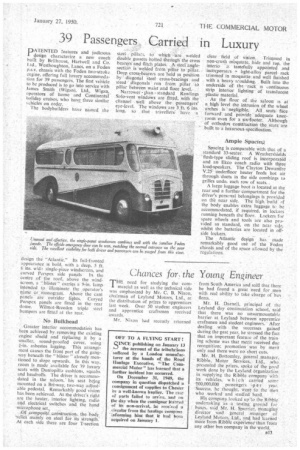39 Passengers Carried in Luxury
Page 55

If you've noticed an error in this article please click here to report it so we can fix it.
PATENTED :features and judicious 1. design characterize a new coach buift by Bellhouse, Hartwell and Co. Ltd., Westhoughton, Lanes, on a Foden p.s.v. chassis with the Foden two-stroke engine, offering flail luxury accommodation for 39 passengers. The first vehicle to be produced is to go into service with James Smith (Wigan), Ltd., Wigan,. operators of home and Continental holiday cruises, who have three similar '.chides on order.
The bodybuilders have named the
'design the "Atlantic." Its full-fronted appearance is -bold., with a deep, 5 ft. &its. wich single-piece windscreen, and curved Perspex side panels In the centre of the roof, above the windscreen, a " blister" carries 4 9-in. lamp intended to. illuminate the operator's . name'. Or. Monogram'. Above the cant panda' are outrider lights. Curved Perspex panels are fitted in the rear dome. Wilmot-Breeden triple steel bumpers are fitted at the rear.
No Bulkhead •
. -Greater interior accommodation has been achieved by removing the existing engine shield and replacing it by a smaller, sound-proofed cover, using 4-in, asbestos lagging. This arrangement causes the front part of the gangway beneath the " blister "-already mentioned to slope upwards. In this way, room is made available for 39 luxury seats with Duntopillo cushions, squabs and headrolls. The driver is accommodated in the saloon, his seat bejng Mounted on a Bri-way, two-way .adjust-' able pedestal. .Remarkably good vision has been achieved. At the driver's .right are the heater, interior lighting, radio .and, electrical switches and the . hand -microphone Set., . • . Of eornposite construction.. .the bOdy. eli Mainly on steel for -its Strength. At each side there are four '-fsection steel. pillars, to which are welded double gussets bolted through the cross bearerS' and flitch plates. A steel 'anglesection is welded from pillar to pillar. . Deep cross-bearers are held in position by .diagonal -steel cross-braCings and steed diagonals run from pillar..to pillar between waist aid floor level..
Narrower jhan standard Rawlings Solo-vent vvinchSws are fitted, with the channel . well above the ,passengets' eye-level. The windows are 3.ft..6 ins. long, so that travellers' have -a
Chances for, the
THE need for studying the com mercial as well as the technical side was emphasized. by Mr..C. B. Nixon, chairman of Leyland Motors, Ltd., at the distribution of prizes to apprentices last week. Over 50 student engineers and apprentice craftsmen received awards.
Mr. Nixon had recently returned clear field of vision. Trimmed in non-crush inbquette, hide and rep, the interio tastefully appointed and incorporates light-alloy parcel rack trimmed' in moquette and well finished with a heavy toouldtng. Built into the underside of the rack is ..ontinuous strip interior lighting of translucent plastic material.
As the floor of the saloon Is at a high level the intrusion Of the wheel arches is negligible. Ali seats face forward and provide adequate kneeroom even for a six-footer. Although of orthodox construction the seats are built to a luxurious specification.
Ample Spacing
Spacing is comparable with that of a standard 33-seater. A Weathershields flash-type sliding roof is incorporated and an Eke° coach radio with three loud-speakers. The Clayton Dewandre V.25underfloor heater feeds hot air through .ducts in the side combings to grilles uncle, each row of seats. _ A large luggage boot is located at the rear' and a further compartment for the driver's personal belongings is provided on ttie near side. The high. build -4 the bedy enables extra luggage to be accommodated, if reqiiired, in lockers running beneath the floor. Lockers for spare wheels and tools are also provided as standard, on the near sid,e, whilst the batteries are located in offside lockers.
The Atlantic design has made remarkably good use of the Foden chassis and of the space allowed by the regulations.
Young Engineer
from South America and said that there he had found a great 'need for men with real ability to take charge of bus fleets.
Mr. H. Darneli, principal of the Leyland day continuation school, said that there was no unsurmountable barrier at Leyland between apprentice craftsmen and student engineers. After dealing with the successes gained during the past year, he stressed the-fact that an important feature of the training scheme was that merit received due recognition; promotion was by merit only and there.were no short cuts.
Mr. H. Bottomley, general manager, Ribble \ Motor Services, Ltd., who presented the prizes, spoke of the good work done by the Leyland organization in supplying the Ribble company with its vehicles, which carried some
200,000,000 passengers p e r year. Success., he thought, went to the then who worked and studied hard... .
His company looked up'to the :Ribble undertaking as a testing gronnd for huss.. said Mr. H. Spurner', managing .director -find genera) maphger of Leyland ..Motors, .Ltdz, and had learned more from Ribble experience: than from any other bus company in the world.




























































































